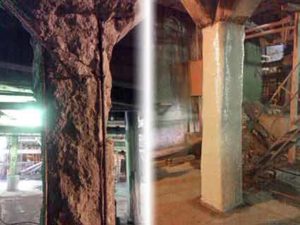†Structural Reinforcement of Concrete: A Viable Solution for Sustainability The issue of structural reinforcement for concrete is not confined to any single nation—it’s a worldwide challenge. We frequently hear about the degradation of critical infrastructure like bridges, harbors, and water conduits, but the crux of the matter lies in the concrete itself, particularly the reinforced concrete that includes steel bars. Modern concrete is simply not as durable as its ancient Roman counterpart. In his book “The Concrete Planet,†Robert Courland highlights how Roman concrete structures have endured for over 2,000 years, whereas contemporary concrete may only last a century, if we’re lucky. On top of that, cement production ranks third globally in terms of CO2 emissions, just after cars and coal-fired power plants. Expanding our current infrastructure by producing more concrete is environmentally unsustainable. Fortunately, there are innovative solutions available, such as carbon fiber reinforcement, which not only saves costs but also minimizes ecological damage. Concrete reinforcement or replacement becomes essential when a structure’s strength capacity diminishes or requires enhancement. This could happen due to changes in the structural load requirements or corrosion of the steel reinforcement inside the concrete. Vibrations from industrial operations or traffic, along with temperature fluctuations, can cause small cracks in concrete, which can typically be fixed. However, when air, moisture, and chemicals infiltrate reinforced concrete, they lead to rusting of the steel reinforcement, causing it to expand and break apart the surrounding concrete. This eventually results in the spalling or detachment of concrete, leading to the deterioration of various structures, including buildings, roads, bridges, dams, levees, homes, airports, sewage systems, schools, canals, power plants, grain silos, piers, and tunnels, among others. Repairing concrete is an eco-friendly alternative to outright replacement since it helps preserve energy. The creation of cement, which is mixed with water and aggregates to form concrete, is a highly energy-consuming process. According to the World Coal Association, cement production demands vast amounts of energy, with coal often being burned during the process. This has significant environmental implications as it necessitates large quantities of coal in powdered form, where approximately 450 grams of coal produces about 900 grams of cement. Cement production releases CO2, with each ton of cement usually emitting around one ton of CO2, and sometimes even more. Alternative methods like carbon fiber reinforcement can be used to strengthen concrete structures. These materials are lightweight, simple to install, and do not add extra weight to the existing structure. Furthermore, it’s a more sustainable way to maintain infrastructure, as carbon fiber utilizes a byproduct of oil refining that would otherwise go to waste. When considering the entire lifecycle, including transportation, energy consumption, and resource use, the environmental impact of carbon fiber is significantly lower than that of traditional steel and concrete repairs or replacements. HJ3’s carbon fiber repair systems offer up to a 60-90% cost reduction compared to complete replacement, allowing clients to extend the lifespan of their infrastructure for many years. Additionally, they reduce operational downtime, making them a popular choice for end-users. HJ3’s carbon fiber systems are widely used to reinforce columns, beams, walls, slabs, silos, pedestals, piles, underground pipes, manholes, and concrete tanks. There are two main approaches to reinforcing deteriorating concrete structures. The conventional method involves replacing existing concrete infrastructure with new concrete, which is both energy-intensive and generates substantial CO2 emissions. The alternative, more sustainable method employs advanced composite systems for infrastructure repair, such as carbon fiber. Carbon fiber is not only faster and simpler to install, but it also proves more economical when considering factors like materials, transportation, permits, downtime, and labor costs. If you have a concrete structure that requires reinforcement and wish to explore HJ3’s concrete repair systems, feel free to reach out to our project managers at . ††aluminum foil wrapping paper ,aluminum foil paper roll ,aluminum foil food wrapping paper ,reasonable price aluminum paper foil roll ,low price aluminum foil paper roll Qingzhou Xincheng Packaging Co., LTD , https://www.qzxcbc.com
